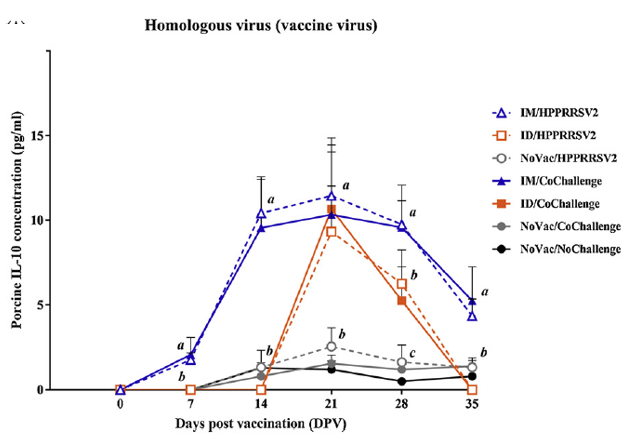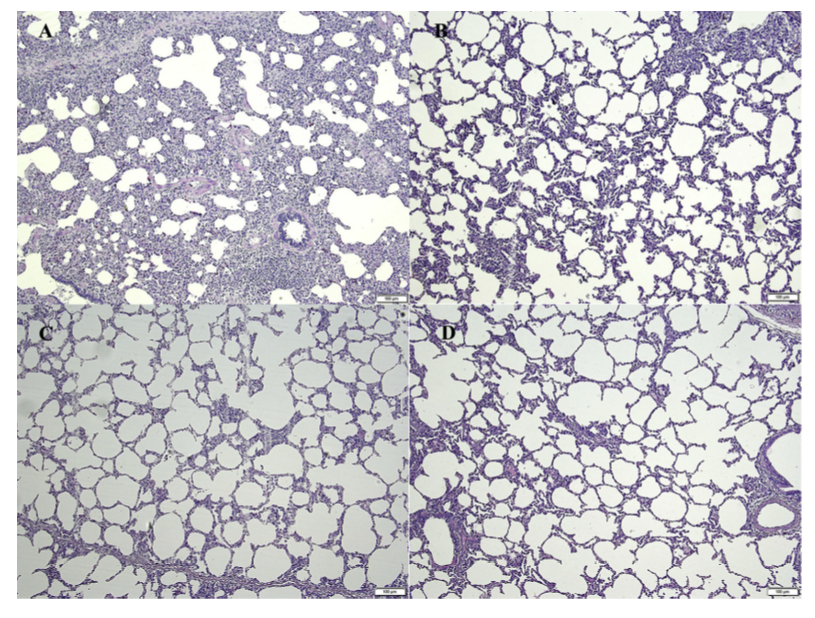



Is the intradermal vaccination against PRRS as efficacious as the intramuscular one??
The advantages of the intradermal (ID) administration by a needle-less device are that it is less invasive, painless, safe, quick and easy. Furthermore, the ID administration could induce a stronger cellular response compared to the intramuscular (IM) due to the delivery through the ID route could induce T cell polarization favoring the induction of interferon gamma secreting cells (IFN-γ-SC). In PRRSV infection, interleukin 10 (IL-10) levels are reportedly associated with severity of clinical disease (van Reeth and Nauwynck, 2000) and can delay the immune response. Higher IFN-γ-SC in ID vaccinated pigs could be due to the lower IL-10 levels.The objectives of the present study were to investigate the immune response and clinical protection of pigs vaccinated IM or ID with UNISTRAIN® PRRS (Laboratorios HIPRA) against challenge with HP-PRRSV2 (Thai strain) and coinfection with PRRSV1. Moreover, the second objective of this study was to learn more about safety of the vaccine by evaluation of IL-10 production as it can delay the immune response (Madapong et al., 2020).
Material and methods:
Forty-two, 3-week-old, PRRSV-free pigs were allocated into 7 groups as shown in Table 1. Following vaccination and challenge at 35 days post vaccination, pigs were monitored for PRRSV quantification by RT-qPCR, safety of the vaccine by IL-10, immune response including ELISA and IFN-γ-PC and macroscopic lung lesions.

Results
Following vaccination, there was no difference in antibody response among vaccinated groups. ID-vaccinated pigs had shorter viremic phase and lower RNA level compared to IM-vaccinated pigs. ID-vaccinated pigs had significant lower IL-10 levels (figure 2), and significant higher IFN-g-SC compared to IM-vaccinated pigs (figure 3). Following challenge, ID-vaccinated pigs had significantly lower PRRSV RNA and lung lesion compared to IM-vaccinated pigs at 7 days post challenge (DPC) (figure 4 and 5).




Conclusions
The results of the study suggested that:
- Vaccination with UNISTRAIN® PRRS, either by IM or ID, can induce humoral and cell-mediated immune responses.
- UNISTRAIN® PRRS administered by either IM or ID can provide heterologous protection against challenge with HP-PRRSV-2, either alone or in coinfection with PRRSV-1, as demonstrated by reduced lung lesions and viremia.
- IL-10 production was delayed and lower in ID vaccinated pigs.
In conclusion, the ID route might represent an alternative to improve vaccine efficacy, as it induced lower IL-10 levels and more IFN-γ-SC.
| References | ||||
|---|---|---|---|---|
| van Reeth, K., Nauwynck, H., | ||||
| (2000) | Proinflammatory cytokines and viral respiratory disease in pigs.. Vet. Res. | 31, 187–213. | ||
| Madapong, A et al., | ||||
| (2020) | Immune response and protective efficacy of intramuscular and intradermal vaccination with porcine reproductive and respiratory syndrome virus 1 (PRRSV-1) modified live vaccine against highly pathogenic PRRSV-2 (HP-PRRSV-2) challenge, either alone or in combination with of PRRSV-1,. Veterinary Microbiology, | Volume 244. |









